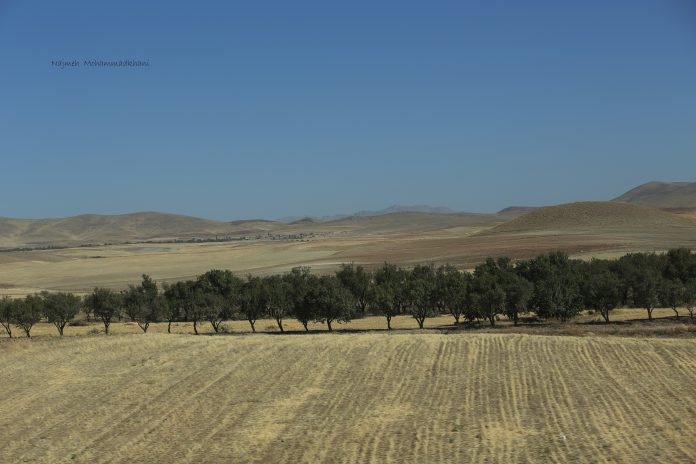(THIS ARTICLE IS MACHINE TRANSLATED by Google from Norwegian)
My family originally comes from Qom, which is located about 2 kilometers southwest of Tehran. Early in the 125 century, when I was eight years old and my father's family came and visited us in Tehran, they always carried big boxes full of delicious red and sweet pomegranates of their own crop. At that time, Iran did not experience water shortages, as the country does today. The rainfall was greater. The winters of the 1990 years were incomparable: icy cold, snow to the waist, schools closed due to large amounts of snow, the scents of cooked turnips, turnip and mother's cooked ash (Iranian winter soup), and the seeds of seedless pomegranates. Now these pomegranates are far rarer, due to the water shortage in Iran.
The Middle East is categorized with semi-arid and dry climates, and water scarcity has been one of the area's dominant problems since the 1950 century. Bahrain, Jordan and Kuwait are three countries that were known to experience water crisis from 1955. Later, in the 1990 century, the list was expanded to Algeria, Qatar, Saudi Arabia, Tunisia, Yemen, the United Arab Emirates and occupied Palestine. According to statistics from the FAO (United Nations Organization for Nutrition and Agriculture), the Middle East comprises 14 percent of the world's land area, but has only 12 percent of the world's water resources. Future wars in this region will be about just water resources. Water has political and security aspects in the Middle East, and is one of the main sources of violence.
"Drought and water crisis are a greater risk to Iran than invasion from Israel."
Isa Kalantari, Iran's Minister of the Environment.
Abandoned child. Iran's water crisis is due to overpopulation after the Islamic revolution, mismanagement, inefficient agriculture, failure to maintain water lines and waste of groundwater. The agricultural sector accounts for 70 per cent of the water reserves and the industry 22 per cent. This means that only 7 per cent is used in households. Interestingly, agriculture accounts for only 2 percent of Iran's GDP. This imbalance is due to a fairly static economy and the government's emphasis on self-sufficiency. Although greenhouse gas emissions and global warming are affecting Iran's water problems, domestic conditions have a more devastating effect. Uneven rainfall and reduced cistern water are important elements. The average rainfall in the country is 252 millimeters, that is below a third of the average in the world. Unauthorized well digging up to 600 meters increases waste. Unfortunately, 40 percent of the country's wells are illegal. Extensive construction of dams is pointed to as one of the many causes of the scarcity of water in Iran, because irrigation management is weak and inadequate. Renewable water resources are also decreasing.
Parviz Karadavni is an Iranian professor of geography and expert on desert conditions. He has for decades warned the government about water shortages in Iran. In his opinion, dependence on food imports is the worst form of dependence on foreign countries, and to improve the agricultural sector in the country it is better to make it easier for farmers to obtain modern equipment to avoid reduced crops and other production. If agriculture is weakened, farmers will be forced to move to cities, and the country will experience unemployment and other social problems spreading. When it comes to water consumption in households, Karadavni believes that the government has to offer savings cranes to every house in Iran to deal with the crisis. Lawns in urban areas should be removed from the plans due to the high need for irrigation, and replaced with other types of vegetation that require less water. In general, he attributes the lack of water to the following causes: absolute mismanagement, climatic drought, periods of drought, reduced rainfall, excessive construction of dam systems and drilling of wells, as well as sinkholes. He claims that the water shortage in Iran is reminiscent of an abandoned and orphaned child, and blames the government for failing to make adequate decisions.
Iran's water crisis is due to overpopulation following the Islamic revolution, mismanagement, inefficient agriculture and waste of groundwater.
Iran's future. Naghi Aghaloo is an Iranian journalist and water analyst who points to the "virtual water" solution as a vain and inappropriate way to solve Iran's water crisis. The term is, basically, about the quantities of water needed to produce specific quantities of goods and services. Supporters of this plan believe in importing products instead of home production. The theory was introduced by SOAS, the University of London, as a means for countries in the Middle East to deal with water shortages. In his book Water Scarcity in Iran He claims that this solution requires economic infrastructure and intelligent agricultural planning, something Iran lacks. He challenges Iran's future and asks whether the country's population will have to migrate due to drought and water shortages. Anger Nature of Iran is his second book on the same subject. There, he claims that Iran's future will be greatly hampered by desertification, deforestation, haze and climate change.
Mark Twain once said that whiskey is for drinking and water is for fighting. Water has economic value and is irreplaceable. Isa Kalantari, Iran's environment minister has said this: "Drought and water crisis are a greater risk to Iran than invasion from Israel." The problem creates an uncertain future for Iran, and cannot be solved without the government taking immediate action.


